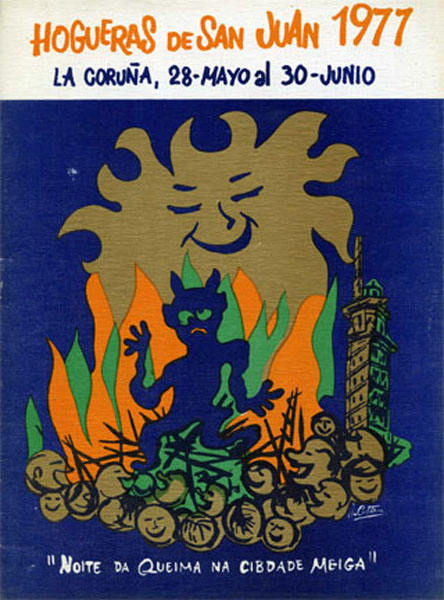OUR FIRST PUBLICATIONS

One of the issues to which we have always devoted special attention since the founding of the Commission for the Promotion of the Bonfires of San Juan in 1971, and even before, in 1970, with the creation of the Meiga Mayor Youth Group, was, not only, the dissemination of our activities, but also that of the festival and the customs and traditions that revolve around the night of San Juan.
Already in the last quarter of 1970, our first informative bulletin came to light, which we baptized with the name of “Meiga Mayor” and whose numbers came out brimming with ink, from the “Vietnamese” of the Parish of San Pio X, throughout the last three months of that year and the first six of 1971, with a good part of the girls and boys who made up the board of directors of our Group participating as editors.
It was a kind of organ of expression, in which we told a little about our associative realities and a lot about our dreams and projects, through articles and comments, many of them loaded with subtlety and good humor.
In 1971, the creation of the Commission for the Promotion of the Bonfires of San Juan, resulted in the change of the header of our Bulletin, which was renamed “Aquelarre”, maintaining its reason for being and its structure, also changing the “rotary”, beginning to use the electric duplicating machine of the Compañía Asturiana de Minas.
With long periods of disappearance, this Bulletin has survived to this day, edited in digital format and of which a total of fifteen numbers are published each year, twelve monthly and three extraordinary on the occasion of San Juan, Christmas and the Election of the Meiga Mayor .
For many years we toyed with the idea of launching a larger publication on the streets that would serve, on the one hand, as a disseminating support for our program, and on the other, as a means of disseminating the customs and traditions associated with the night of San Juan. However, such a publication had to wait a few years to become a reality.
In 1972, we edited our first HOGUERAS poster that would become a constant throughout the years, reaching our days.
Drawings and photographs, some of them by famous cartoonists, constituted, during these fifty years, the central themes of the posters, whose collection constitutes part of the historical heritage of our Promotion Commission of which we feel especially proud.
Even during these early years, Begano S.A., the Coca-Cola bottler in our city, printed a series of partial posters of some of our events that served to better publicize them.
It was in 1977, when we turned to the soft drinks firm Schweppes, which had a bottling plant in the neighboring Polígono de Sabón, to finance our project to publish a publication and thus be able to make it a reality.
Presented our demands to his head of the advertising area, he accepted our proposal and in this way, that year, with the help of the magnificent cartoonist and friend, Joaquín Castiñeiras Bermúdez, the first publication of HOGUERAS went out into the street, experimenting when seeing it , all of us, a feeling of indescribable emotion.
Published in page format and with a full-color cover, its content basically consisted of listing the acts to be carried out in those HOGUERAS, accompanied by some background articles and, of course, the photograph of Isabel Ruso de Lago, Meiga Major 1977.
Since that year, the HOGUERAS publication has never stopped going out, adopting years later, specifically in 1984, the A-4 format and the full color edition, always featuring the year’s general poster on its cover.
Nor can we forget that nice little newsletter that, under the title of “Ella” we published throughout most of the editions of the Sports Week and that constituted, to put it in some way, the organ of expression and the voice of the Week , coming to light, each year, a total of seven copies that were distributed among the participants.
Over the years, our publications reached greater scope and thus the magazine “HOGUERAS” notably improved its presentation and content, exhibition catalogs and even books were published, but we will talk about this on another occasion.
Eugenio Fernández Barallobre.


